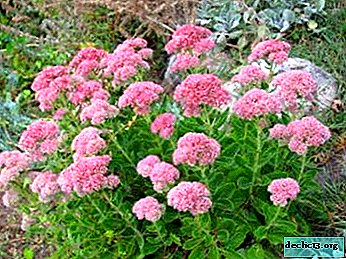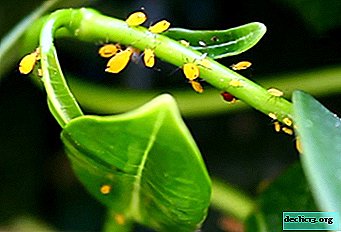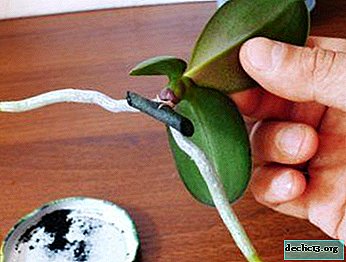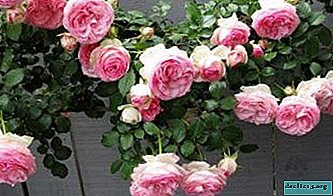What is Kalanchoe garden, what are the features of growing and what does it look like in the photo?

Kalanchoe is a favorite of all people, both the smallest and all adults. Adult women like to resort to traditional medicine.
This popularity is due to the fact that this plant has a beautiful appearance and has many useful properties. People, among the people, received several names “tree of life”, “deer horns”, “home doctor”.
In this article we will talk about the varieties of this flower, about caring for it. Also watch a helpful video on the topic.
Botanical Description and History
ATTENTION: Garden or street kalanchoe has become so popular due to its unique method of reproduction, and not just because of its unpretentiousness in caring for itself.The flower of this plant can reach a height of up to 50 centimeters. The leaves of this plant are heavy and have an oval shape with denticles along the edges. Children appear in the plant from brood buds, which in turn are located in the hollows between the serrated edges.
Garden Kalanchoe has its own rootsthat grow directly on the mother plants. This young flower begins to appear roots, it grows and develops as soon as the baby falls to the soil. This representative of Kalanchoe has one stalk, without any branching.
Leaves grow up to 24 centimeters in length, but it depends on the care of him. The leaves have a beautiful sheen, as well as a beautiful green color with a slight shade of blue. If the plant is absolutely healthy, then its leaves will grow all the time up, and the edges are slightly bent down.
The stem of this plant is rather weak and needs support. After a certain time, the extreme leaves begin to fade and fall, because of this the stem becomes bare.
The birthplace of Kalanchoe is the island of Madagascar. Also widespread in fears of Asia in the tropic zone. Ornamental varieties of this plant grow in Africa. Ornamental varieties also grow in tropical Africa. Priests of African tribes used it for rituals, since it was considered a symbol of strength. In the 18th century, Kalanchoe was first mentioned among Europeans. Kalanchoe in Europe arose only at the source of the 19th century.
Varieties and features
This beautiful plant has over 100 types.. The most popular are:
- Tubular.
- Cirrus.
- Degremon.
- Rosaline.
- Kalandiva
- Mini mix.
- Blossfeld.
- Behara (we wrote about Behara and felt Kalanchoe here).
Photo
And so on the photo Kalanchoe street (garden).
Tubal-flowered
Cirrus
Degremona
Kalandiva
Behar
Where and how to plant?
The operation to plant already grown flowers or still quite young shoots is quite simple at home. To do this, you need to create open ground on the street yourself. But you can buy the finished substrate in the store.
In order to make the soil yourself you need to take:
- Four parts of deciduous land.
- Two parts of turfy land.
- One part of compost.
- One piece of sand.
Charcoal or drainage should also be added to the substrate.. If there is no desire or time to create the soil for the future plant, then, as mentioned above, you can buy it in flower shops. Soil must be selected special for succulents. It is he who can retain moisture for a long time. In addition to this soil for succulents, you can use universal soil, but you must add coconut fiber or a little perlite to it.
If you transplant with cuttings, then this will be most favorable for the plant, as new plants will quickly appear. For this procedure, it is necessary to cut off the stem of a small plant in an adult plant and put it in a container with water at room temperature for the appearance of roots.
In the same container with water, it will not be superfluous to add 2 tablets of activated carbon to avoid rotting. To do this, a small stem is cut off from the parent flower and placed in water to form roots. There you can add two tablets of activated carbon to avoid decay.
Lighting and location
 This plant is absolutely calm about lighting.. It will be best to place Kalanchoe in the summer on the windowsills, the windows of which overlook the western and eastern sides. In the winter season, he will be more favorable on the windowsills, whose windows face the south.
This plant is absolutely calm about lighting.. It will be best to place Kalanchoe in the summer on the windowsills, the windows of which overlook the western and eastern sides. In the winter season, he will be more favorable on the windowsills, whose windows face the south.
Direct sunlight should not be allowed - this can lead to burns on its leaves. With a lack of lighting, the plant will stretch, and its buds will become small and invisible.
One of the most important points for caring for this plant is twelve-hour lighting. In order for the plant to grow and develop rapidly, as well as abundant flowering, it is necessary to create additional lighting for the plant in winter.
Soil requirements
Any soil for succulents is suitable for Kalanchoe., which can be purchased at flower shops. If desired, the soil mixture can be made independently, taking in equal parts sheet and turf soil, peat and sand. It is desirable to add charcoal or perlite to the mixture. There should be drainage at the bottom of the pot.
Proper care
This plant can withstand quite high temperatures, up to 30 degrees Celsius. In the winter season, the temperature should be from 16 degrees to 18 degrees Celsius. This will be the optimal temperature regime for its normal flowering and development of Kalanchoe.
IMPORTANT: At high and low temperatures, the process of laying the kidneys can noticeably slow down.Kalanchoe also applies to humidity. It tolerates dry air at high temperatures and at low temperatures with high humidity. It will sometimes be useful to spray lightly with water. This plant should be watered frequently and regularly. How often to water depends on several factors, for example: air temperature and plant size.
If the plant is a little in the shade, then you need to water moderately once every two to three days, while focusing on the dryness of the soil. In the winter season, watering should be reduced to a minimum. They react sharply to high high humidity, but they can hardly tolerate low humidity.
Only if the plant becomes crowded in a pot, it must be transplanted. In early spring, pruning of young shoots begins. They should be made shorter by half the length.
Common Diseases and Pests
It is quite difficult for this plant to pick up any pests, but it can also become infected with pests such as:
- Aphid.
- Mealybug.
- Root Worm.
- Spider mite.
Breeding
This plant propagates most favorably with the help of cuttings.. Since the transplant is carried out in the spring, then the bush is formed in the spring.
At this time, it is necessary to cut off fresh shoots and dig in wet sand. After half a month the root system will appear, and then you can transplant it into a separate pot.
Watch the video about the propagation of Kalanchoe by cuttings:
Conclusion
Kalanchoe is not only a rather picky and unpretentious plant, but also a hardy plant. Kalanchoe can adapt to almost all growing conditions. It is able to survive even with poor-quality care for this plant.
Suitable for both an experienced grower and beginner growers. But this does not mean at all that leaving this plant is completely unnecessary, since only with proper care will Kalanchoe delight everyone with its flowering for a long time.

















